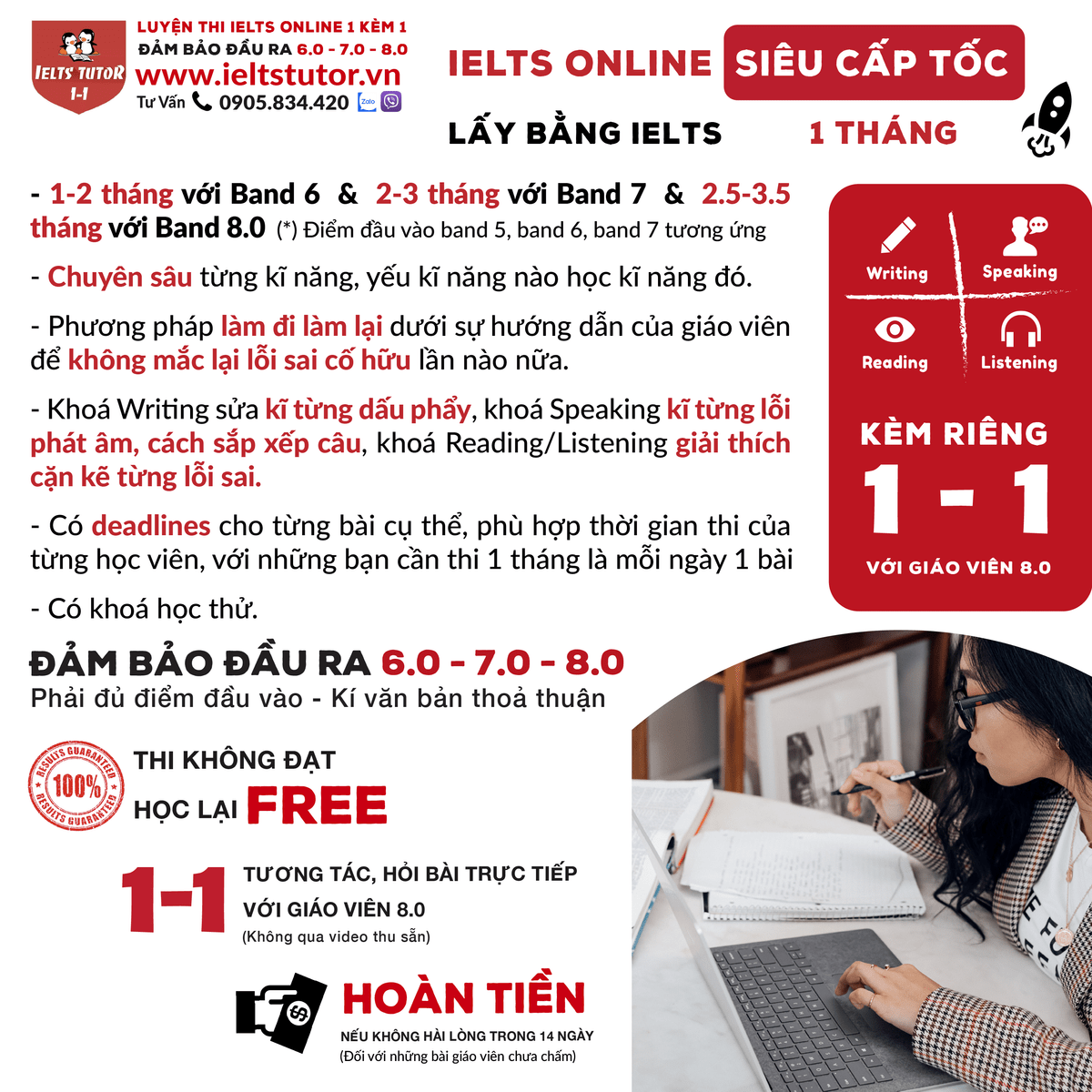IELTS TUTOR cung cấp 🔥The First Aircraft Answers with location - Đề luyện IELTS READING- Làm bài online format computer-based, kèm đáp án, dịch & giải thích từ vựng - cấu trúc ngữ pháp khó
I. Kiến thức liên quan
II. Làm bài online (kéo xuống cuối bài blog để xem giải thích từ vựng & cấu trúc cụ thể hơn)
📩 MN AI CHƯA CÓ ĐÁP ÁN FORECAST QUÝ MỚI PART 1-2-3 NHẮN ZL 0905834420 IELTS TUTOR GỬI FREE HẾT NHA
III. The First Aircraft: Đề luyện IELTS READING (IELTS Reading Practice Test)
The First Aircraft
IELTS Reading Passage
You should spend approximately 20 minutes on Questions 1-8, which are based on the Reading Passage below.
The First Aircraft
The dream of flying has been nurtured since humans lay their eyes on birds. In ancient times, people tried flying by emulating the birds. They constructed ornithopters, flying machines with wings, to take off like birds. However, this did not work since it was obvious that a larger machine was required to lift the body from the ground and propel it forward. In 1783, some daring aeronauts were able to fly using balloons filled with hydrogen or hot air which were lighter than air. But the flight was possible only when the wind would blow in a desired direction. Although these “aerostatic machines” did not make any technical contributions to manned heavier-than-air flight, they postulated the theory that humans could fly.
It was in 1799 that Sir George Cayley, a baronet from Yorkshire, came up with the basic concept of the airplane—a flying machine with fixed wings, movable control surfaces, and a propulsion system. The Cayley silver disc, where he inscribed his idea, is preserved in the Science Museum of London. He also made the first true airplane, which was actually a glider with a kite fixed on a pole at an angle of incidence of 6 degrees and had a movable cruciform tail attached with universal joints. Cayley separated the concepts of lift and thrust against the convention of earlier scientists that both could be generated by the propulsion system, and he set into motion a century of aeronautical development that resulted in the first-ever aircraft by the Wright brothers.
Building on the pioneering works of Sir George Cayley, engineers and scientists began building and experimenting with airplanes. In 1849, a boy became the first person to fly in a glider designed by Cayley. Louis Charles Letur built and tested a parachute glider. This was the first attempt at a controlled flight in a heavier-than-air machine. After several successful descents, Letur met with a serious accident and succumbed to injuries. Felix Du Temple and his brother Louis flew a model monoplane with propellers driven by a steam engine, making the first successful flight of a powered aircraft. The plane took off under its own power for a short distance and glided to a safe landing. Sir Hiram Maxim made the first successful takeoff in an uncontrolled flight in 1894. Otto Lilienthal made controlled flights by shifting his weight to steer a small glider. This success inspired the Wright brothers, Wilbur and Orville Wright, to experiment with aerodynamic surfaces to control an airplane in flight. These experiments led them to come up with the first controlled and sustained flight of a powered heavier-than-aircraft in 1903 in Kitty Hawk, North Carolina.>> tham khảo CẦN VIẾT & THU ÂM BAO NHIÊU BÀI ĐỂ ĐẠT 8.0 SPEAKING & 7.0 WRITING?
From the beginning of their experiments, the two brothers focused on developing reliable pilot control that was key to solving the flying problem. The main breakthrough of the brothers was understanding and applying the concept of the three-axis control to fly an aircraft, which allowed them to steer the aircraft effectively and to maintain its equilibrium.
The Wright brothers' 1903 airplane was made up of the wings that generated most of the lift and held the plane in the air. They used twin pusher propellers that were located behind the wings and turned by a small gasoline-powered internal combustion motor. The propellers were meant to overcome the airplane drag and generate the thrust. To achieve the three-axis control, the Wright brothers used different mechanisms. The aircraft had an all-moving elevator at the front that controlled the up and down movement of the nose, which is called pitch. At the rear of the aircraft was a rudder, which controlled the side-to-side movement of the nose, also called yaw. The rudder also allowed coordinated turns. The up and down movement of the wings, known as roll, was provided by twisting the tips of the wings to change the lift on the outer sections of the wings. The body of the airplane that held all the parts together was made of a light framed structure that was not covered due to the low flight speed. The captain of the plane would lie on the wing next to the engine since this aircraft had no seats.
The Wright’s first powered airplane flew at Kitty Hawk on December 17, 1903. The plane made a 12-second flight and travelled 120 ft. Orville was the pilot. The flight of the day was with Wilbur at the controls that covered 852 ft. in 59 seconds. The Wright brothers were the pioneers of the basic techniques of modern aeronautical engineering. After their breakthrough, more scientists were involved in the perfection of the basic design, and this led to the evolution of the modern-day aircraft.
The First Aircraft Reading Questions
Questions 1-8
Label the diagrams below.
Choose NO MORE THAN TWO WORDS AND/OR A NUMBER from the passage for each answer.
Sir George Cayley’s Airplane
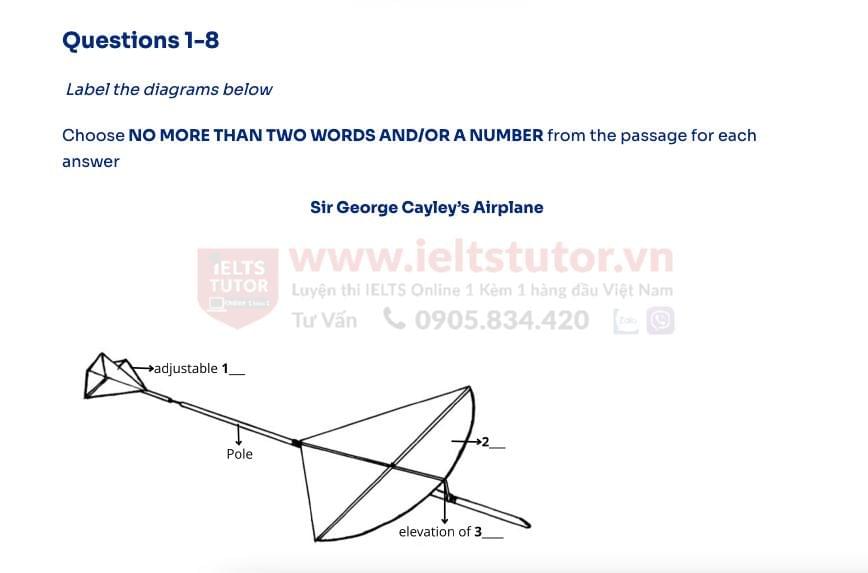
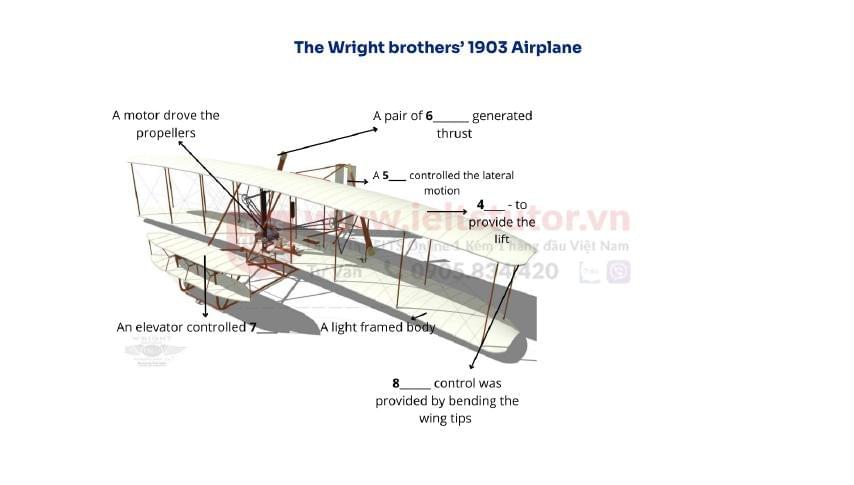
IV. Dịch bài đọc The First Aircraft
Giấc mơ bay lượn đã được nuôi dưỡng (*nurtured – cultivated, encouraged, fostered) kể từ khi con người nhìn thấy chim chóc. Vào thời cổ đại, con người đã cố gắng bay bằng cách bắt chước (*emulating – imitating, copying, mirroring) loài chim. Họ đã chế tạo những chiếc máy bay vỗ cánh (*ornithopters – winged machines, flapping machines, bird-like aircraft) có cánh nhằm cất cánh như chim. Tuy nhiên, điều này không hiệu quả vì rõ ràng rằng một cỗ máy lớn hơn là cần thiết để nhấc cơ thể khỏi mặt đất (*lift the body from the ground – elevate, raise, hoist) và đẩy nó tiến về phía trước (*propel it forward – thrust, drive, push ahead).
Năm 1783, một số nhà hàng không táo bạo (*daring aeronauts – bold pilots, brave fliers, adventurous balloonists) đã có thể bay bằng khinh khí cầu được bơm đầy hydro hoặc không khí nóng – nhẹ hơn không khí. Nhưng chuyến bay chỉ có thể thực hiện khi gió thổi theo hướng mong muốn. Mặc dù những chiếc “máy bay khí tĩnh học” (aerostatic machines – balloons, buoyant aircraft, floating vehicles) này không đóng góp kỹ thuật nào cho chuyến bay có người lái nặng hơn không khí, chúng đã đề xuất (*postulated – proposed, theorized, suggested) lý thuyết rằng con người có thể bay.
Đến năm 1799, Sir George Cayley – một ngài Nam tước (*baronet – nobleman, aristocrat, titled gentleman) đến từ Yorkshire – đã đưa ra khái niệm cơ bản (basic concept – fundamental idea, primary notion, essential theory) của máy bay: một cỗ máy bay với cánh cố định, các bề mặt điều khiển có thể di chuyển và một hệ thống đẩy (*propulsion system – thrust mechanism, power unit, engine system). Đĩa bạc của Cayley (*Cayley silver disc – metal plate, invention record, historical artifact), nơi ông khắc ý tưởng của mình, được lưu giữ tại Bảo tàng Khoa học London. Ông cũng đã chế tạo chiếc máy bay thật sự đầu tiên – thực chất là một chiếc tàu lượn (*glider – sailplane, airfoil, non-powered aircraft) với một cánh diều được gắn vào cột theo một góc tới (*angle of incidence – inclination angle, attack angle, flight tilt) 6 độ, cùng với một đuôi hình chữ thập có thể di chuyển được gắn bằng các khớp nối vạn năng (*universal joints – flexible connectors, rotating links, pivot points).
Cayley đã tách biệt (*separated – distinguished, divided, split) hai khái niệm lực nâng và lực đẩy (lift and thrust – elevation and propulsion, hoist and push, upward force and drive) trái với quan điểm của các nhà khoa học trước đó rằng cả hai đều có thể được tạo ra từ hệ thống đẩy. Ông đã khởi xướng (*set into motion – initiated, triggered, started) một thế kỷ phát triển hàng không dẫn đến chiếc máy bay đầu tiên do anh em nhà Wright chế tạo.>> Form đăng kí giải đề thi thật IELTS 4 kĩ năng kèm bài giải bộ đề 100 đề PART 2 IELTS SPEAKING quý đang thi (update hàng tuần) từ IELTS TUTOR
Dựa trên những công trình tiên phong của Sir George Cayley, các kỹ sư và nhà khoa học bắt đầu xây dựng và thử nghiệm máy bay. Năm 1849, một cậu bé trở thành người đầu tiên bay trên một chiếc tàu lượn (*glider – sailplane, airfoil, non-powered aircraft) do Cayley thiết kế. Louis Charles Letur đã chế tạo và thử nghiệm một chiếc tàu lượn có dù (*parachute glider – gliding parachute, air descent device, winged chute). Đây là nỗ lực đầu tiên nhằm điều khiển chuyến bay (*controlled flight – guided flight, regulated flying, directed aviation) bằng một cỗ máy nặng hơn không khí. Sau vài lần hạ cánh thành công, Letur gặp một tai nạn nghiêm trọng và đã qua đời vì vết thương (*succumbed to injuries – died from wounds, passed away due to trauma, perished from harm).
Felix Du Temple và anh trai Louis đã bay thành công với một mô hình máy bay một cánh (*model monoplane – single-wing model aircraft, prototype aircraft, winged device) có cánh quạt được vận hành bằng động cơ hơi nước (*steam engine – steam-powered motor, boiler engine, vapor engine), đánh dấu chuyến bay đầu tiên thành công của một máy bay có động cơ (*powered aircraft – engine-driven aircraft, motorized plane, propelled airplane). Chiếc máy bay tự cất cánh một quãng ngắn rồi lượn xuống an toàn (*glided to a safe landing – descended gently, floated down safely, landed smoothly).
Sir Hiram Maxim đã thực hiện thành công lần cất cánh không kiểm soát (*uncontrolled flight – unmanaged flying, unguided takeoff, unpiloted movement) đầu tiên vào năm 1894. Otto Lilienthal đã bay bằng cách điều khiển tàu lượn bằng trọng lượng cơ thể (*shifting his weight to steer – leaning to guide, adjusting body to control, tilting for direction). Thành công này đã truyền cảm hứng (*inspired – motivated, encouraged, influenced) cho anh em nhà Wright – Wilbur và Orville Wright – để họ tiến hành thí nghiệm với các bề mặt khí động học (*aerodynamic surfaces – airflow-controlling surfaces, wing elements, flight-control panels) nhằm điều khiển máy bay khi bay. Những thí nghiệm đó đã dẫn họ đến việc chế tạo thành công chuyến bay đầu tiên có điều khiển và duy trì (*controlled and sustained – managed and continuous, guided and prolonged, stable and ongoing) của một máy bay có động cơ nặng hơn không khí vào năm 1903 tại Kitty Hawk, North Carolina.
Ngay từ khi bắt đầu các thí nghiệm của mình, hai anh em Wright đã tập trung vào việc phát triển hệ thống điều khiển phi công đáng tin cậy (*reliable pilot control – dependable steering system, consistent guidance, trustworthy handling), vốn là yếu tố then chốt để giải quyết vấn đề bay lượn. Đột phá lớn nhất (*main breakthrough – key innovation, major advancement, significant discovery) của hai anh em là việc hiểu và áp dụng khái niệm điều khiển ba trục (*three-axis control – tri-directional control, triple-axis guidance, multi-axis steering) để điều khiển máy bay, cho phép họ điều hướng hiệu quả và duy trì trạng thái cân bằng (*equilibrium – balance, stability, steadiness).
Chiếc máy bay năm 1903 của anh em nhà Wright bao gồm các cánh tạo ra phần lớn lực nâng (*lift – upward force, elevation, raising power) và giữ máy bay trên không. Họ sử dụng hai cánh quạt đẩy (*pusher propellers – rear propellers, thrusting blades, drive rotors) được đặt phía sau cánh và được quay bằng một động cơ đốt trong chạy bằng xăng (*gasoline-powered internal combustion motor – petrol engine, fuel-burning engine, spark-ignition motor). Các cánh quạt này có nhiệm vụ vượt qua lực cản của máy bay (*overcome the airplane drag – counteract air resistance, fight aerodynamic friction, reduce pulling force) và tạo ra lực đẩy (*thrust – propulsion, push, drive).
Để đạt được điều khiển ba trục, anh em Wright đã sử dụng nhiều cơ chế khác nhau (*different mechanisms – varied systems, alternative devices, distinct setups). Máy bay có một bộ điều khiển độ cao (*all-moving elevator – full-motion pitch control, front flap, adjustable nose stabilizer) ở phía trước, điều khiển chuyển động lên xuống của mũi, gọi là pitch (độ nghiêng dọc). Phía sau máy bay là một bánh lái (*rudder – tail fin, vertical stabilizer, steering flap), điều khiển chuyển động qua lại của mũi, còn gọi là yaw (độ lệch hướng). Bánh lái cũng cho phép máy bay rẽ phối hợp (*coordinated turns – balanced turning, harmonized direction change, smooth curve). Chuyển động lên xuống của cánh, gọi là roll, được điều khiển bằng cách xoắn đầu cánh (*twisting the tips of the wings – bending wingtips, angling edges, flexing ends) để thay đổi lực nâng ở hai bên ngoài cánh.
Thân máy bay, nơi giữ tất cả các bộ phận lại với nhau (*held all the parts together – connected components, integrated structure, assembled frame), được làm từ một kết cấu khung nhẹ (*light framed structure – lightweight skeleton, minimal framework, airy chassis) và không được bao phủ vì tốc độ bay thấp. Người điều khiển nằm bên cạnh động cơ trên cánh, vì chiếc máy bay này không có ghế (*had no seats – was seatless, lacked chairs, was without seating).
Chiếc máy bay chạy bằng động cơ đầu tiên của anh em nhà Wright đã bay tại Kitty Hawk vào ngày 17 tháng 12 năm 1903. Chiếc máy bay đã thực hiện một chuyến bay kéo dài 12 giây và di chuyển được 120 feet. Orville là người điều khiển máy bay (*pilot – aviator, flyer, airman). Chuyến bay đáng chú ý nhất trong ngày (*flight of the day – highlighted journey, key flight, main takeoff) là với Wilbur điều khiển, bay được quãng đường 852 feet trong 59 giây.
Anh em nhà Wright là những người tiên phong (*pioneers – trailblazers, forerunners, innovators) trong các kỹ thuật cơ bản (*basic techniques – fundamental methods, core skills, essential practices) của kỹ thuật hàng không hiện đại. Sau bước đột phá (*breakthrough – milestone, leap forward, game-changer) của họ, ngày càng nhiều nhà khoa học tham gia vào việc hoàn thiện thiết kế cơ bản (*perfection of the basic design – refinement of structure, enhancement of model, improvement of blueprint), và điều này đã dẫn đến sự phát triển (*evolution – advancement, progression, transformation) của máy bay hiện đại ngày nay.
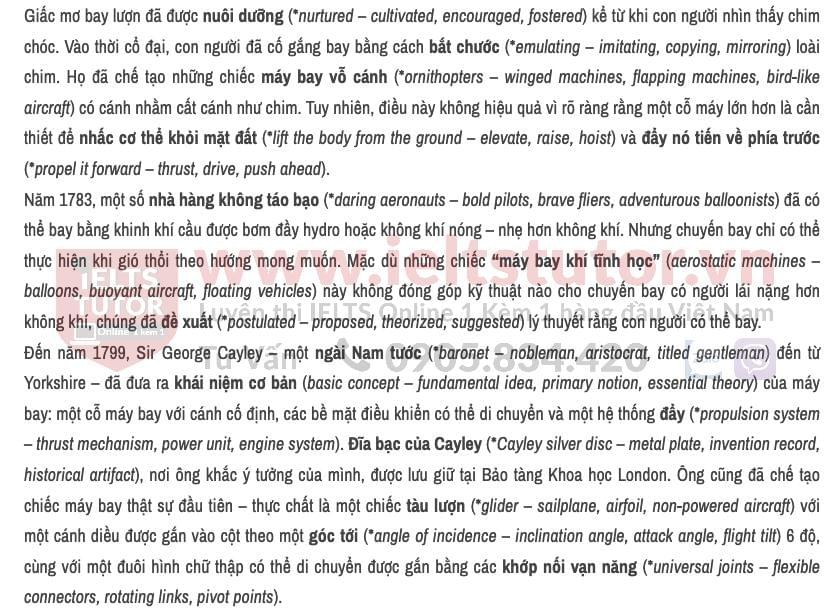
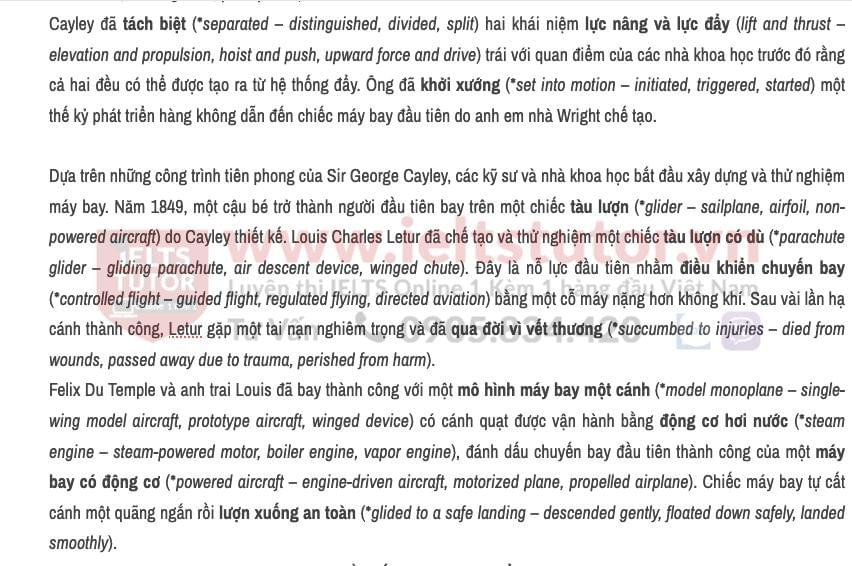
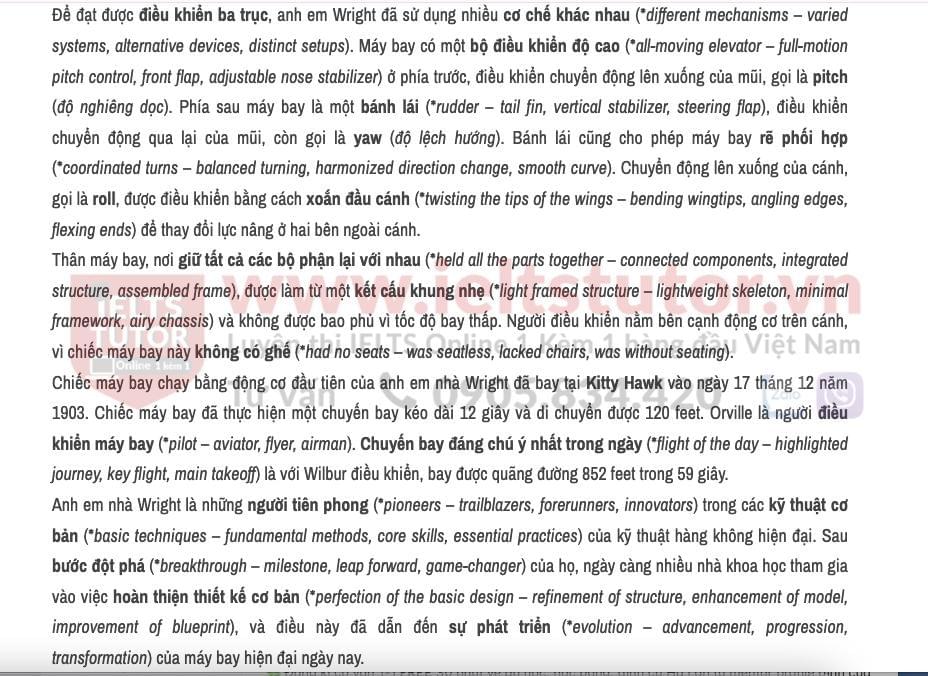
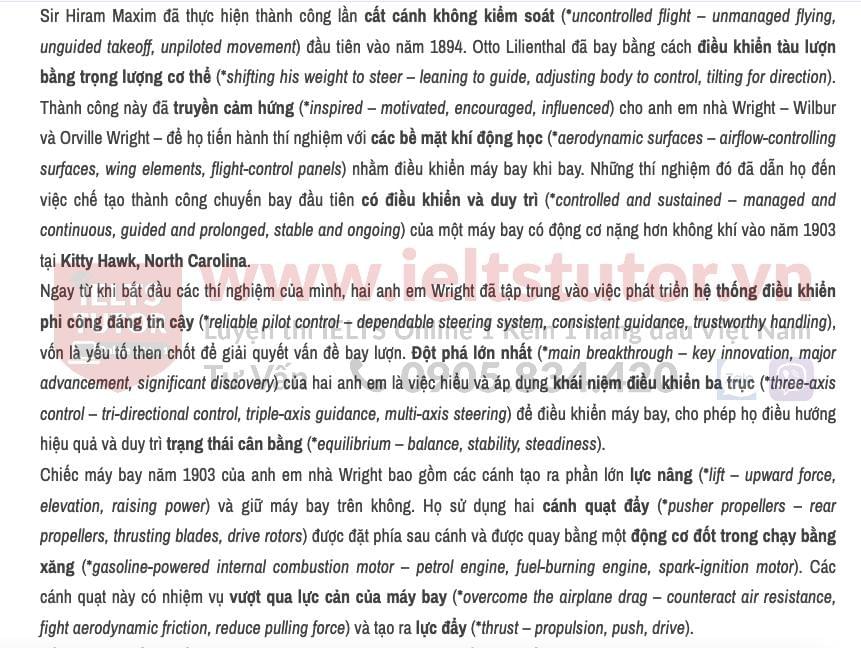
V. Giải thích từ vựng The First Aircraft
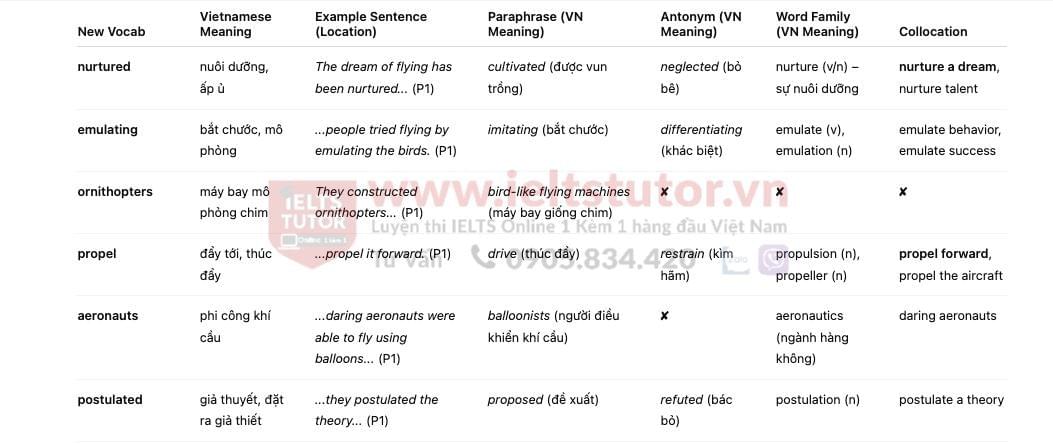
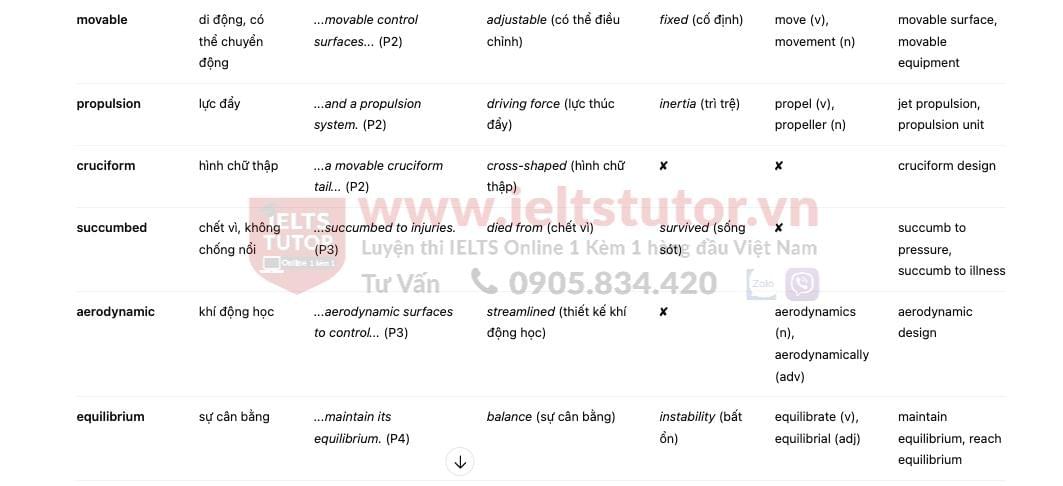
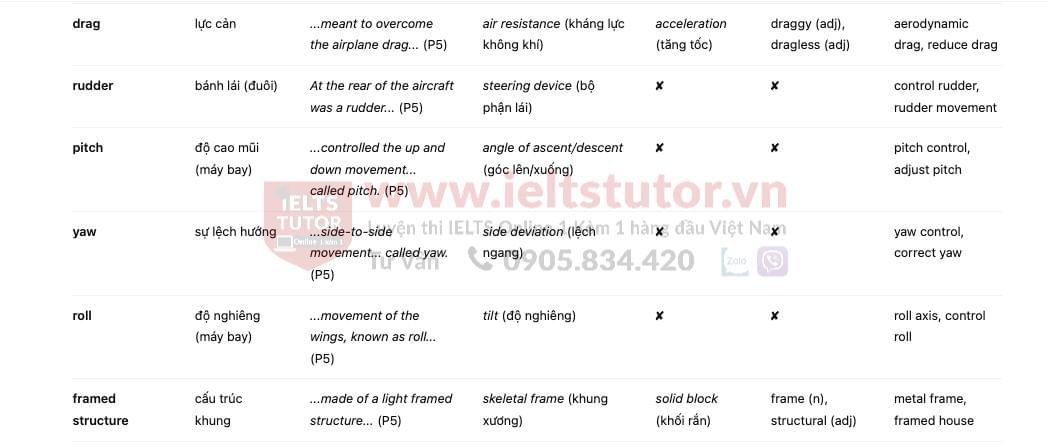

VI. Giải thích cấu trúc ngữ pháp khó The First Aircraft
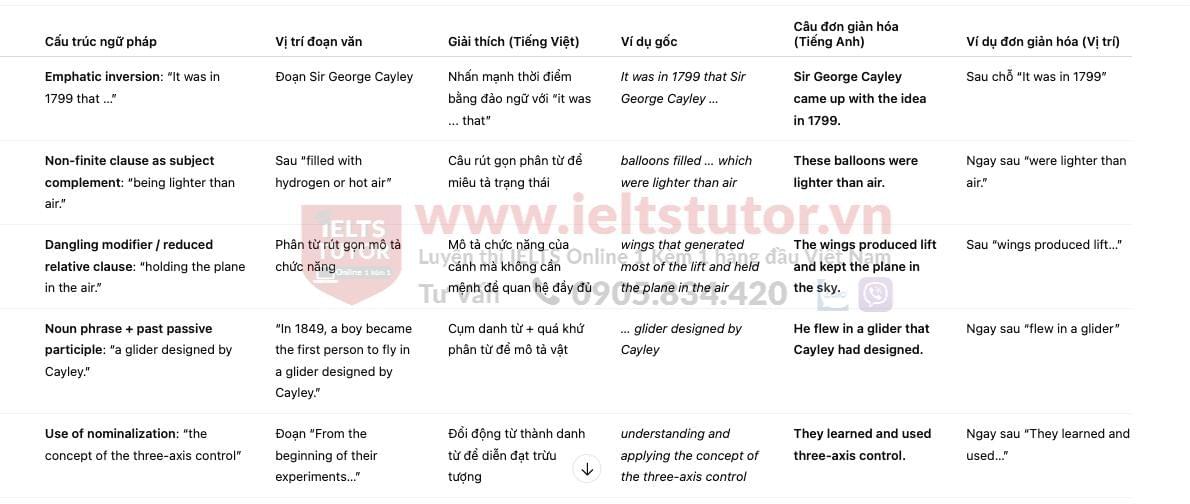

VII. Đáp án The First Aircraft
1. cruciform (tail) – From Paragraph 2: "...had a movable cruciform tail attached with universal joints."
2. Kite – From Paragraph 2: "...a glider with a kite fixed on a pole..."
3. 6 degrees – From Paragraph 2: "...at an angle of incidence of 6 degrees..."
4. (the) wings – From Paragraph 5: "The Wright brothers' 1903 airplane was made up of the wings that generated most of the lift..."
5. Rudder – From Paragraph 5: "At the rear of the aircraft was a rudder which controlled the side-to-side movement..."
6. Propellers – From Paragraph 5: "They used twin pusher propellers that were located behind the wings..."
7. Pitch – From Paragraph 5: "...the up and down movement of the nose which is called pitch."
8. Roll – From Paragraph 5: "The up and down movement of the wings known as roll..."
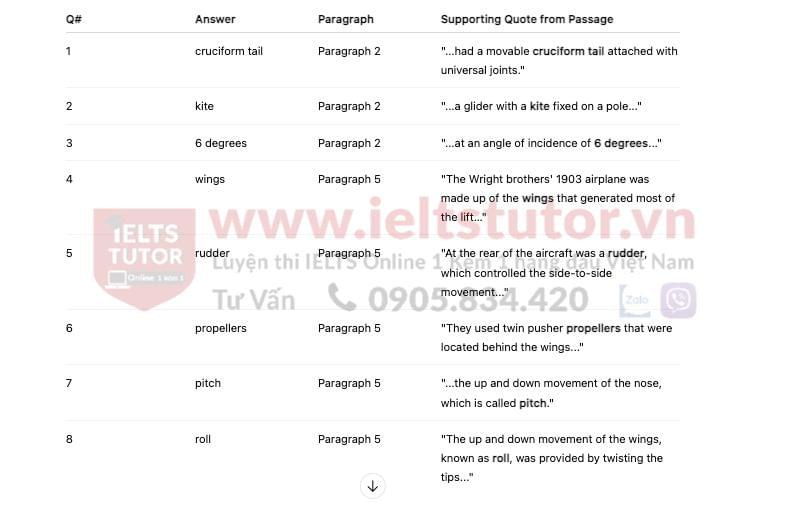
📩 MN AI CHƯA CÓ ĐÁP ÁN FORECAST QUÝ MỚI PART 1-2-3 NHẮN ZL 0905834420 IELTS TUTOR GỬI FREE HẾT NHA

Các khóa học IELTS online 1 kèm 1 - 100% cam kết đạt target 6.0 - 7.0 - 8.0 - Đảm bảo đầu ra - Thi không đạt, học lại FREE
>> Thành tích học sinh IELTS TUTOR với hàng ngàn feedback được cập nhật hàng ngày
